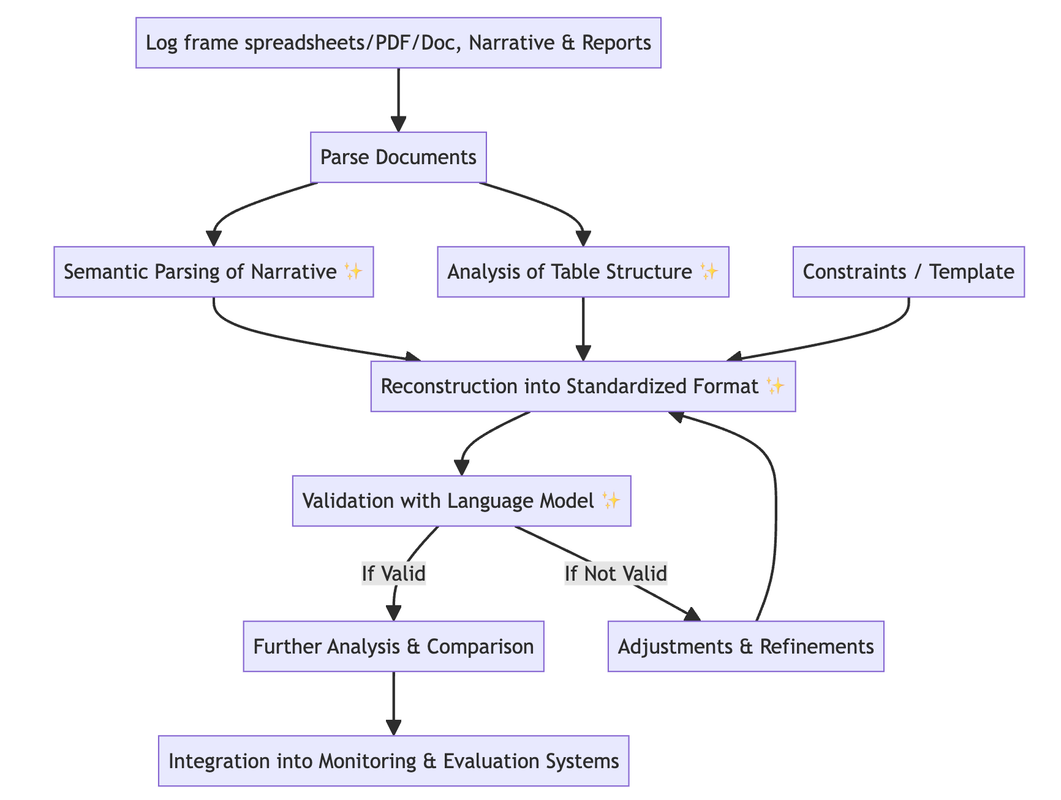Simplifying log frame analysis using AI
Introduction
Don’t we just love logframes! Seriously though, PM and M&E staff working on them deserve a badge because in the realm of project management and development, understanding, assessing, reviewing and utilizing log frame data is complex and tedious. This complexity stems not only from the details of log frame structures but also from the myriad of formats in which they are presented even when you “follow the template”. A coherent, standardized method for interpreting these diverse formats into a language model (LM)-friendly structure can significantly enhance analysis capabilities, enabling more straightforward comparisons and deeper insights into project frameworks.
We can essentially chat with our log frame, get insights, find incongruences, compare it to others, dig in deeper, make log frames fun again! 😬
The challenge
Log frames, or logical frameworks, are essential tools for planning and evaluating projects, especially within international development sectors. They outline objectives, activities, outputs, outcomes, and indicators in a structured manner. However, the varied formats and the frequent use of merged cells in tools like Excel complicate the extraction and interpretation of this data. The challenge lies in transforming these often semi-structured or poorly structured documents into a format that is both human-readable and machine-processable.
Compounding this issue is the necessity to maintain the hierarchical and logical relationships outlined in these frameworks, which are crucial for proper analysis and understanding. The diversity of formatting and structuring practices across organizations further exacerbates the problem, making standardized analysis and comparison almost unattainable.
The solution: combining narrative and tabular data
With the advancement of Large Language Models (LLM), Baobab Tech proposes a straightforward, no-frills solution to this problem. By leveraging the combined strengths of narrative texts and semi-structured table data, we aim to reconstruct log frames into a standardized, LM-friendly format. This reconstructed format will not only be consistent across different projects but will also be structured in a way that facilitates further analysis, comparison, and summarization of project data, as well as verify and validation alignment with templates, standard indicators and other constraints by specific development agencies
Step-by-step process
- Extraction of text and table data: The initial step involves parsing documents to extract both the narrative descriptions and the semi-structured table data, ensuring that no critical information is lost.
- Semantic parsing of narrative: We apply LLM techniques to the narrative text to identify and categorize key elements such as objectives, indicators, and assumptions. This step leverages the contextual understanding capabilities of LMs to accurately interpret the underlying project framework.
- Analysis of table structure: Concurrently, the semi-structured table data is analyzed to discern its inherent structure. This involves identifying headings, subheadings, and the logical flow of information, even in the absence of a clear tabular format.
- Reconstruction into a standardized format: Utilizing insights from both the narrative and table analysis, we reconstruct the log frame into a structured format that accurately represents the project’s logical framework. This reconstruction process ensures that the hierarchical and logical relationships are maintained and clearly presented.
- Validation and refinement: The reconstructed log frame undergoes a validation process against the original documents. This step ensures consistency, completeness, and coherence, with adjustments made as necessary to accurately reflect the project’s framework.
To streamline this process, we can develop scripts and tools that automate the extraction, analysis, and reconstruction steps, making it easy for users to convert their documents into the standardized format.
Here is a flow-diagram illustrating the process, with ✨ indicating AI (LLM) tooling:

Benefits and further applications
This standardized, LM-friendly log frame format opens up numerous possibilities for project management and evaluation. It facilitates deeper analysis by enabling easier comparison across different projects, thus identifying trends, efficiencies, and areas needing improvement. Moreover, this format can be integrated into monitoring and evaluation systems, enhancing the ability to track progress and outcomes effectively.
Beyond analysis, this approach significantly simplifies reporting, allowing project managers and stakeholders to generate concise summaries and insights into their projects’ status and impact. By standardizing the format, we also pave the way for using this data in predictive modeling, helping to forecast project outcomes and inform decision-making processes.
Conclusion
At Baobab Tech, our focus is on delivering practical, straightforward solutions to complex problems using AI. By addressing the challenge of interpreting diverse log frame formats through a combined analysis of narrative and tabular data, we offer a standardized approach that enhances project analysis, comparison, and reporting. This solution reflects our commitment to simplifying project management and evaluation processes, making them more accessible and actionable for organizations worldwide.
If you are interested in contributing your knowledge or ideas to this solution, or apply it in your own organization and day-to-day work, do reach out